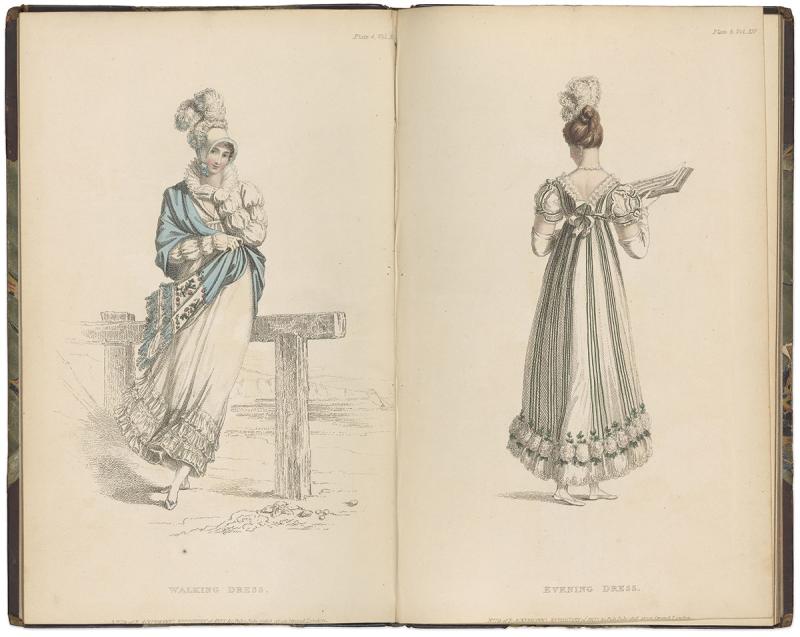Listen to co-curator Juliette Wells describe two ensembles from a 19th century fashion magazine.

PROMOTING BRITISH FABRICS
Published monthly from 1809 to 1828, Rudolph Ackermann’s Repository purveyed culture in all its forms, from fashion illustrations, to engravings of aristocrats’ houses, to articles about current events. This book of plates taken from the Repository presents ensembles for every activity that a gentlewoman might pursue throughout the day and evening. Each issue contained samples of British-made fabrics, along with advice about where to buy and how to use each material. Surviving sets of swatches, like these, offer a glimpse of the rich colors, bold patterns, and luxuriant textures available to customers in the Regency era (the period from 1811–20 when the Prince Regent, George III’s eldest son, reigned in place of his father, who was incapacitated by illness).
Fashion plates from The Repository of Arts, Literature, Commerce, Manufactures, Fashions and Politics, 1814–16
The Morgan Library & Museum; PML 5682
Fashion plates in Ackermann’s Repository depicted ensembles owned and worn by an actual woman. “Mrs. Bean, of Albemarle-street,” was thanked in the July 1815 issue for supplying the walking dress and evening dress shown in these two plates. In the original periodical, each plate was accompanied by detailed descriptions of every element and accessory. Readers learned that this walking dress was “made of French cambric or jaconot muslin, trimmed at the feet with treble flounces of French work . . . the body made with open fronts, worn with a full ruff of the French work.” Complementing the dress is a “French bonnet of white satin, edged and tied under the chin with satin ribbon of celestial blue; ornamented with a rich plume of white feathers, edged to correspond.” For footwear, one could choose “slippers, or half-boots, of blue kid, or primrose colour.”
The evening dress consists of “a white satin slip, worn under a dress formed of tull, with folds of satin of Pomona green and white alternately let in, terminating at the feet with a rich flounce of blond lace, headed with a broad border of white roses, appliqued with lilies of the valley.” The headdress is “a plume of ostrich feathers,” and the necklace, “ear-drops and bracelets” are pearl.
